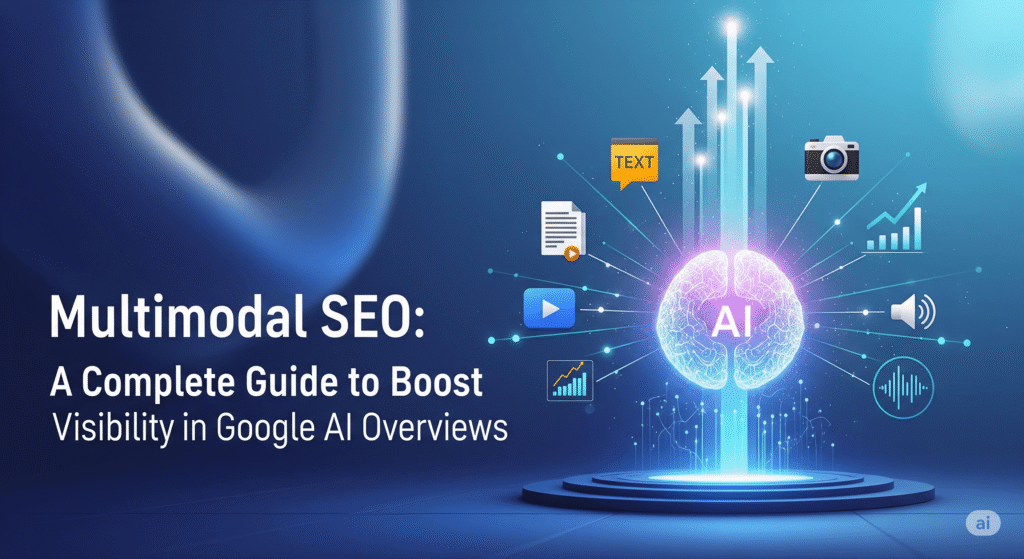In 2025, SEO is no longer just about great text content. As Google’s AI Overviews increasingly dominate search real estate, getting featured requires more than just well-written articles. AI Overviews prioritize multimodal content—a blend of text, images, videos, tables, and structured data.
This shift means marketers, bloggers, and SEO specialists must rethink their approach. If your content isn’t multimodal, it risks being overlooked. In this comprehensive guide, we’ll explore how to structure and enrich your content for maximum discoverability in AI-driven search results.
Why Multimodal Content Matters in 2025
Google’s AI Overviews are designed to summarize comprehensive answers from across the web. They now pull from content that offers:
- Rich, descriptive images
- Clear and labeled data tables
- Transcribed video content
- Helpful captions and contextual information
AI models parse these formats more effectively when the content is structured and accessible. That means optimizing your multimedia assets is as important as your written words.
1. Use Descriptive, Natural Alt Text
Alt text isn’t just for accessibility anymore. Search engines and AI models now read alt attributes to understand image content contextually.
Best Practices:
- Write in natural language
- Describe the image accurately and concisely
- Avoid keyword stuffing
Example:
- ✅
alt="red brick greenhouse with sliding door" - ❌
alt="greenhouse greenhouse greenhouse"
Pro Tip: Prioritize unique descriptions for each image. Don’t repeat identical alt text across multiple images.
2. Rename Image Files Before Upload
Search engines (and AI models) also read the filenames of your images. If your file is named IMG_3412.JPG, it provides zero context. But a file like bamboo-planter-lobby.jpg instantly offers semantic cues.
Best Practices:
- Use lowercase letters and hyphens
- Include 1-3 relevant keywords naturally
- Avoid generic terms like “image” or random numbers
Example:
- ✅
organic-tea-shelf-display.jpg - ❌
IMG_0912.jpg
3. Use HTML Tables Instead of Image Charts
Posting screenshots of charts might look good visually, but AI and search crawlers can’t read them. Instead, use HTML <table> tags to make your data both readable and indexable.
Why it Matters:
- AI can parse table structure and generate summaries from them
- Enhances accessibility for screen readers
- Increases chances of appearing in AI Overviews and featured snippets
Example: Instead of an image, use:
<table>
<tr>
<th>Product</th>
<th>Price</th>
<th>Rating</th>
</tr>
<tr>
<td>VPN Crafter</td>
<td>$4.99/month</td>
<td>4.8/5</td>
</tr>
</table>4. Transcribe Video Content
Videos are powerful tools, but without transcription, their content remains hidden from search engines.
Benefits of Transcription:
- Makes video content indexable
- Improves user experience and accessibility
- Supports multilingual and diverse audiences
How to Implement:
- Use services like Otter.ai or Descript to auto-generate transcripts
- Review and format them for clarity
- Embed the transcript directly below the video or in a collapsible section
5. Add Contextual Captions and Descriptions
Captions not only help users understand your visuals, they also help AI contextualize them. Use descriptive headings, figure captions, and surrounding text to explain what’s in the image, video, or table.
Best Practices:
- Use
<figcaption>tags with images where appropriate - Include labels or titles for charts, infographics, and diagrams
- Mention visual content in nearby text
Example:
<figure>
<img src="solar-panel-efficiency.jpg" alt="solar panels installed on rooftop">
<figcaption>Figure 1: Solar panel efficiency over a decade</figcaption>
</figure>6. Update High-Traffic Pages First
Rather than starting from scratch, begin by revisiting the content that already drives traffic. Google already values these pages, so adding multimodal elements gives them an even stronger chance of appearing in AI Overviews.
What to Add:
- Visual summaries (images, graphics)
- Embedded videos or explainers
- Real data tables and downloadable charts
Checklist:
- ✅ Add 2-3 relevant images with alt text
- ✅ Include an HTML table or data list
- ✅ Embed a short explainer video
- ✅ Add transcript and caption
- ✅ Update meta tags and image filenames
7. Prioritize EEAT Elements
With Google emphasizing Experience, Expertise, Authoritativeness, and Trustworthiness (EEAT), ensure your multimodal content is backed by:
- Author bios with credentials
- Cited sources for data visuals
- Branded visuals with consistent design
- Transparent disclosure of partnerships (if applicable)
Tip: Use structured data markup (like Article, Author, Organization, VideoObject) to reinforce EEAT signals.
8. Optimize Load Speed and Accessibility
Heavy media content can impact site speed and usability. To balance rich content with performance:
- Compress images and videos without sacrificing quality
- Use lazy loading for below-the-fold content
- Ensure your videos and tables are mobile-friendly
Tools to Use:
- TinyPNG or Squoosh for image compression
- Google Lighthouse for performance audits
- WAVE for accessibility evaluation
9. Integrate Structured Data Markup
Structured data (schema) helps search engines understand your content. For multimodal assets:
- Use
ImageObject,VideoObject, orTableschema - Include metadata like title, description, upload date, and creator
- Validate with Google’s Rich Results Test
Example for Video:
{
"@context": "https://schema.org",
"@type": "VideoObject",
"name": "Multimodal SEO Tips",
"description": "Learn how to optimize content for AI Overviews.",
"thumbnailUrl": "https://example.com/video-thumb.jpg",
"uploadDate": "2025-06-15",
"contentUrl": "https://example.com/multimodal-seo-video"
}Final Thoughts
Google’s AI Overviews signal a profound evolution in search. Static text alone is no longer enough. To thrive in this new SEO era, your content must be multimodal—rich in format, structured in presentation, and insightful in value.
By implementing these strategies, not only do you increase your chances of being featured in AI Overviews, but you also provide a more comprehensive, user-friendly experience that builds authority and trust.
Start small. Update your top-performing pages. Add one new format at a time. The future of SEO is multimodal—and the time to adapt is now.

